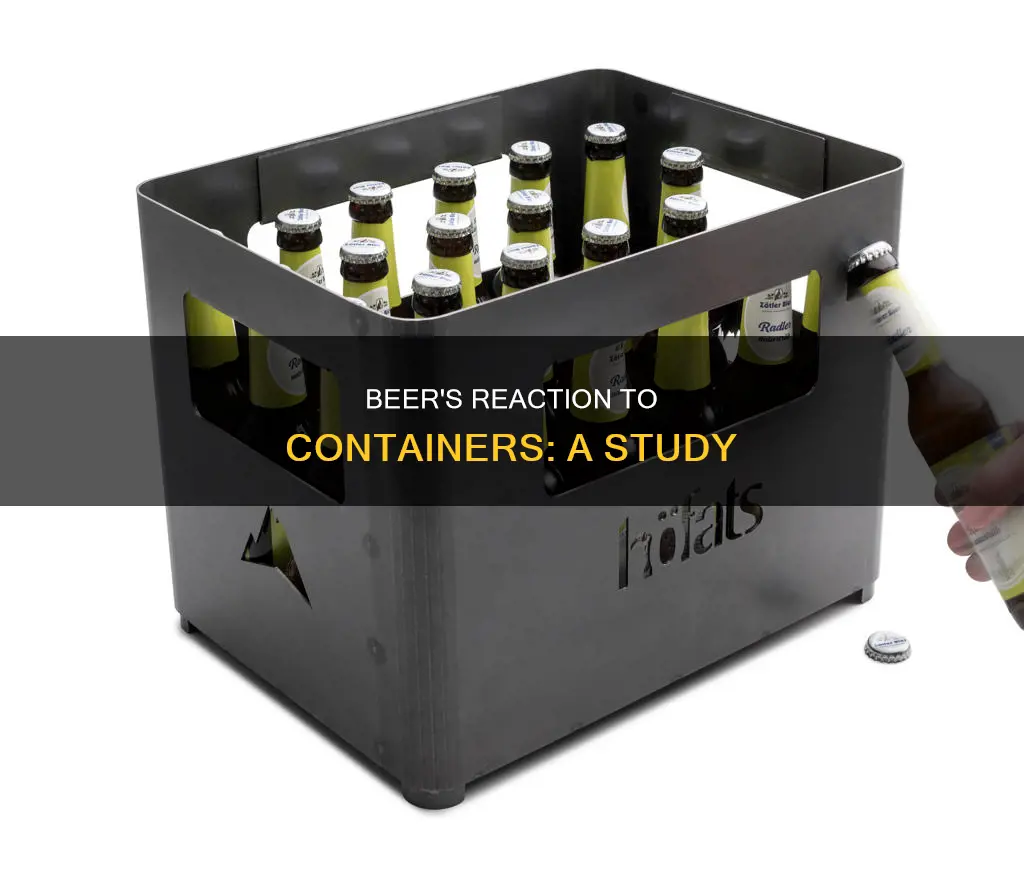
Beer is usually stored in glass bottles or aluminium cans, but some parts of the world, like the UK, also use plastic bottles. The type of container can affect the taste of the beer. Glass bottles are usually brown, green, or clear, with brown glass letting in the least light and clear glass letting in the most. Beer that is exposed to light can become lightstruck or skunked, developing a skunky flavour. Aluminium cans are also opaque, which protects the beer from light. Plastic bottles, on the other hand, are more porous than glass, so beer in plastic bottles can go flat more quickly. Plastic bottles can also leech chemicals, like the toxic metalloid antimony, into the beer.
How does beer react to different containers?
| Characteristics | Values |
|---|---|
| Taste | Beer in plastic bottles can become flat due to carbon dioxide escaping. Aluminium cans are coated with a special polymer to prevent aluminium leaching into the beer. |
| Light protection | Brown glass bottles protect beer from ultraviolet light, which can cause an unpleasant odour and flavour. Clear and green glass bottles offer little protection. Aluminium cans are opaque and protect beer from light. |
| Safety | Plastic bottles are safer than glass bottles at events with drunk people. |
| Stacking | Beer cans can be stacked. |
| Pasteurisation | Plastic bottles can warp during pasteurisation. |
| Refermentation | Refermentation is not possible in cans. |
What You'll Learn

Beer in cans can develop a metallic taste
The perception of a metallic taste in canned beer has contributed to the stigma surrounding beer cans, with some serious beer drinkers considering it inferior to bottled beer. However, experts like Master Cicerone Pat Fahey refute the idea that cans have an impact on the flavour of the beer. Fahey attributes the metallic taste to the smell of the can and not the beer itself.
To avoid the metallic taste, it is recommended to pour the beer into a glass before drinking. This not only eliminates the smell of the can but also enhances the drinking experience by allowing you to see and smell the beer. Using a glass can be especially beneficial for craft beers, as it allows you to appreciate the sensory aspects of the beverage.
While the metallic taste in canned beer is often noted, it is important to recognise that it is not a result of the beer itself, but rather the interaction of the drinker's senses with the container. By understanding the relationship between taste and smell, drinkers can make informed choices about their beer consumption and appreciate the complexities of different brewing techniques.
Explore the Difference Between Ales and Lagers in Beer
You may want to see also

Glass bottles protect beer from UV light
The UV rays in sunlight can cause beer to spoil and develop a "skunky" flavour. This occurs when UV rays break down the alpha acids in hops, which then react with the sulfur in the beer to form a chemical that is almost identical to the spray produced by skunks. This process can happen very quickly and result in an unpleasant odour and flavour.
To prevent this, beer bottles are typically made of brown, green, or clear glass. Brown glass bottles filter out most UV light, providing more protection than clear or green glass bottles. However, they may not be as effective as amber glass bottles in blocking UV rays.
In addition to using tinted glass bottles, brewers can also package their beer in a way that prevents light from getting through. This includes using labels or packaging that blocks light or using a secondary container, such as a cardboard box, to provide an additional layer of protection.
By using glass bottles that protect beer from UV light, brewers can help ensure that their product maintains its intended flavour and quality.
Beer Carbonation: CO2 Content Varies by Brew
You may want to see also

Aluminium cans are coated with a polymer to prevent leaching
Aluminium cans are a popular choice for beer packaging, as they are lightweight, stackable, and provide excellent protection against light and oxygen, which can cause beer to become lightstruck and develop a skunky flavour. However, one of the challenges of using aluminium cans for beer packaging is preventing the aluminium from leaching into the beverage, which can have negative health effects.
To address this issue, aluminium cans are typically coated with a thin layer of polymer or epoxy resin. This coating serves as a barrier between the aluminium and the beer, preventing direct metal-to-product contact. The coating also helps to reduce corrosion and extend the shelf life of the beer.
The process of coating aluminium cans involves several steps. First, the cans are cleaned and treated to ensure the coating will adhere properly. Then, the coating is applied, typically through spraying or dipping. The coating may be made of epoxy resins, vinyl, acrylic, polyester, or oleoresin, among other materials. It is designed to be affordable, sprayable, curable, strong, flexible, and sticky.
One of the critical functions of the coating is to prevent the aluminium from leaching into the beer. Aluminium is a reactive metal, and when it comes into contact with certain substances, such as acids or chloride and copper ions, it can dissolve and leach into the beverage. This leaching process can be accelerated by factors such as oxygen concentration, pH, temperature, and pressure.
By applying a polymer coating to the inside of the can, a protective barrier is created, preventing the aluminium from coming into direct contact with the beer. This coating is specifically designed to resist corrosion and protect the integrity of the aluminium can. While no coating is perfect, and some aluminium leaching may still occur, the polymer layer provides a significant level of protection for both the beverage and the consumer.
Stout vs Porter: Unveiling Beer's Dark Secrets
You may want to see also

Plastic bottles can affect the taste of beer
Plastic bottles can significantly affect the taste of beer. Plastic is a porous material that allows carbon dioxide to escape, causing beer to go flat faster than it would in a glass bottle. Plastic is also not taste-neutral like glass, and can chemically interact with its contents. Plastic contains chemicals that can leech into beer, such as the toxic metalloid antimony, commonly found in Polyethylene Terephthalate (PET) plastic. As a result, beer stored in plastic bottles may exceed the safe limits for antimony set by the Environmental Protection Agency.
In addition to altering the taste of beer, plastic bottles also pose challenges for the pasteurisation process. Pasteurisation involves spraying beer with boiling water to kill any remaining microbes and extend its shelf life. However, plastic bottles tend to warp under high temperatures, requiring the use of more expensive, hard-wearing plastics to withstand the process.
The colour of the container is another factor to consider. Clear glass bottles offer more protection against ultraviolet light, which can cause an unpleasant odour and flavour often described as "skunked" or "light struck". Brown glass bottles provide the best protection against UV light, followed by green and clear glass. Introducing colour to plastic bottles can disrupt established plastic recycling initiatives, making them less environmentally friendly than clear plastic bottles typically used by the soft drink industry.
While plastic bottles may be practical for serving beer at large events due to safety and environmental concerns, they can undoubtedly impact the taste of beer. The chemical composition of plastic, its porosity, and its response to pasteurisation temperatures all contribute to potential alterations in the flavour and quality of the beer.
Explore the Diverse World of Beer Styles
You may want to see also

Glass bottles are more environmentally friendly than aluminium cans
When it comes to beer, the container it is packaged in can have an impact on both taste and environmental sustainability. While aluminium cans and glass bottles are both common choices for beer containers, there are several reasons why glass bottles are more environmentally friendly.
Firstly, let's consider the production process. Glass bottles are made from sand, soda ash, and limestone, which are abundant resources. Mining these materials typically does not lead to deforestation and they are less harmful to the environment than mining for bauxite ore, which is used to make aluminium. Bauxite mining can lead to deforestation, especially as it is often found in tropical rainforests. It also produces a large amount of waste and can pollute water and air.
The manufacturing process for aluminium cans is also very energy-intensive. It involves refining bauxite ore into alumina, melting the alumina in an electrolytic cell to produce aluminium, rolling the aluminium into sheets, cutting and stamping the sheets into can shapes, and finally coating the cans with a protective layer. In contrast, glass bottles are made by melting the raw materials in a furnace, pouring the molten glass into moulds, and then annealing and coating the bottles.
Recycling is another important factor to consider. While both aluminium cans and glass bottles are infinitely recyclable, the process of recycling aluminium uses more energy. Recycling a metric ton of glass bottles saves 42 kilowatt-hours of energy, while recycling the same amount of aluminium cans saves 14,000 kilowatt-hours. Additionally, America recycles only about a third of the 10 million metric tons of glass it discards annually, whereas aluminium cans are recycled more frequently.
Transportation costs also favour glass bottles. Aluminium cans are lighter and more compact, but glass bottles are more durable and less breakable. This means that glass bottles may require less packaging during transportation, resulting in additional savings in transportation costs.
Finally, it is worth noting that the choice between aluminium cans and glass bottles is not just about environmental sustainability. Other factors such as cost, durability, transparency, and taste preferences also play a role in determining the best beverage container. However, if environmental impact is a key consideration, then glass bottles are the more sustainable option for beer containers.
What Makes Beer Gas Tanks Unique?
You may want to see also
Frequently asked questions
Yes, the container can affect the taste of beer. For example, beer in plastic bottles can become flat more quickly than beer in glass or aluminium cans. Plastic is also more chemically reactive than glass or aluminium, which can affect the flavour of the beer.
Glass bottles and aluminium cans are the most popular containers for beer. Glass is almost impermeable to gases and chemically neutral, while aluminium is relatively impermeable and coated with a polymer to prevent leaching.
Brown glass reduces the amount of light that can reach the beer, helping to prevent spoilage. Green and clear glass bottles offer less protection against light, and can result in "skunked" or "lightstruck" beer.
Growlers are jug-like containers with a sturdy handle, often used for transporting craft beer. Bombers are larger than traditional beer bottles, typically containing 22 ounces of beer, and are used for special edition or premium beers.
Different beer containers offer advantages such as convenience, creative labelling opportunities, and marketability. For example, growlers are popular for their iconic shape and convenience, while bombers offer more space for beer and unique labels.







